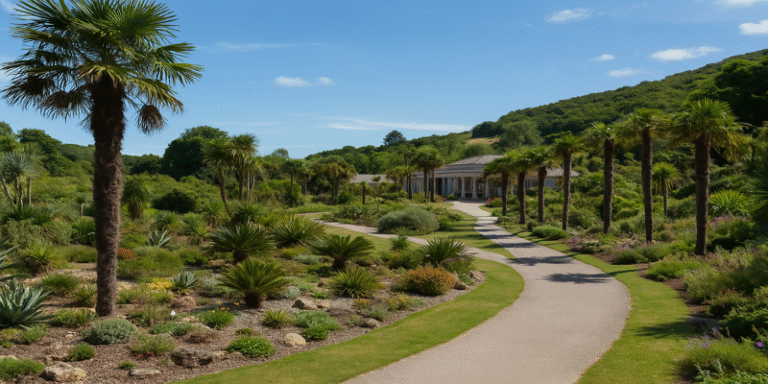Tucked into the south-facing undercliff of the Isle of Wight, Ventnor Botanic Garden is one of the UK’s most unique horticultural destinations. Celebrated for its Mediterranean and subtropical flora, it thrives thanks to a rare microclimate, making it unlike any other botanic space in Britain. With over 30,000 rare and exotic plants, stunning views over the English Channel, and year-round interest, Ventnor is not only a haven for plant lovers but also a vibrant centre for eco-tourism, education, and healing.
The Origins: From Healing Grounds to Horticultural Haven
The site originally housed the Royal National Hospital for Diseases of the Chest, opened in 1869. Patients were treated with rest, clean sea air, and sunshine, as it was believed the sheltered location had curative properties (Rutherford, 2015). When the hospital closed in 1969, the grounds were repurposed into a botanic garden under the guidance of Sir Harold Hillier, one of Britain’s leading horticulturists. His vision was to transform the site into a garden that reflected the climatic potential of the area.
The legacy of healing continues in the garden’s ethos. Today, it is known not just for plant conservation, but also for promoting well-being through nature—a modern return to its therapeutic roots.
The Ventnor Microclimate: Britain’s Hottest Garden
What sets Ventnor apart is its microclimate, generated by the south-facing aspect, cliff shelter, and proximity to the sea. Temperatures at the garden can be 5°C warmer than elsewhere in southern England (Behegan et al., 2023). This unique climate allows the cultivation of semi-tropical species usually seen in the Mediterranean, South Africa, Australasia, and the Canary Islands.
This phenomenon makes Ventnor a living experiment in climate-adaptive horticulture. As climate change brings warmer conditions to Britain, the garden serves as a preview of what future planting schemes may look like across the country (Lennox-Boyd, 2021).
Horticultural Highlights: A Global Collection
The garden is divided into several climatic zones, each mimicking a specific global habitat. Visitors can stroll through:
- The New Zealand Garden, with ferns, palms and hebes
- The Mediterranean Garden, featuring olive trees and lavender
- The South African Terrace, with proteas and agapanthus
- The Australian Garden, home to eucalyptus and acacias
These curated zones not only showcase exotic beauty but also support the conservation of endangered species, many of which are grown from seed collected in the wild (Gilberthorpe, 1987).
The Palm Garden, with its towering Trachycarpus and Phoenix palms, is among the most iconic areas. The Arid Garden further challenges traditional British planting norms with its mix of succulents, aloes and desert flora.
A Tourist Experience: Family-Friendly and Immersive
Ventnor Botanic Garden is more than a visual treat. It’s an immersive experience designed for all ages and interests. Tourists can enjoy:
- Guided tours and audio trails
- Workshops on gardening, art and wellness
- Foraging tours led by chefs and botanists
- Seasonal events such as Garden Fairs and sculpture exhibitions
Families will appreciate the children’s discovery trails, play areas, and the educational focus on plant-animal interactions and biodiversity. The garden café, Edulis, serves fresh meals made with produce from the garden’s own medicinal and kitchen plots.
In 2024, Ventnor introduced its “Botanical Escape” retreat programme, offering wellness packages with yoga, herbal medicine classes and guided mindfulness in nature—aligning the garden with trends in health and nature-based tourism (Uglow, 2012).
Green Tourism and Sustainability
Ventnor Botanic Garden positions itself as a leader in green tourism. It avoids the use of artificial heating in greenhouses and limits water consumption through xeriscaping—a landscaping method that reduces the need for irrigation (Rutherford, 2015).
The garden encourages visitors to travel sustainably via public transport or the Island Line Railway, and its shop offers plastic-free souvenirs, local crafts, and eco-friendly gardening products.
It is also a site for citizen science. Visitors are invited to log sightings of insects, birds, and flowering times, contributing to national climate change monitoring programmes.
Scientific and Educational Importance
The garden is a key site for research and education, working with universities, botanical networks, and plant conservation groups. Its living collections provide valuable insight into plant physiology, adaptation, and climate resilience.
As Gilberthorpe (1987) notes, botanic gardens play a crucial role in educating the public about conservation and environmental change. Ventnor continues this mission with school partnerships, university fieldwork placements, and horticultural apprenticeships.
Cultural and Historical Layers
Walking the garden is also a journey through time. Remnants of the Victorian hospital remain, such as the plaque garden and restored walls. Sculptures and art installations tell the stories of past patients, gardeners, and naturalists who contributed to the site’s development.
Visitors can also explore the Healing Garden, inspired by traditional monastic herb gardens. It revives ancient knowledge of plant-based medicine, connecting historical traditions with modern wellness trends.
Why Visit Ventnor Botanic Garden?
- Unmatched botanical diversity in a unique climate
- A peaceful, family-friendly retreat with learning at its core
- Opportunities to engage with sustainability, nature and wellness
- A chance to explore plant species from around the world—without leaving the UK
- Positioned near Ventnor town, making it perfect for a day trip with beach walks and coastal dining
Whether you are a plant enthusiast, a curious traveller, or a family seeking outdoor fun, Ventnor Botanic Garden offers a rich, multi-sensory experience steeped in history, biodiversity and island charm.
Ventnor Botanic Garden exemplifies how a historical site can be reimagined for modern tourism, blending botany, wellness, and sustainability in an engaging and educational environment. In a world grappling with environmental challenges and a desire to reconnect with nature, this subtropical paradise on the Isle of Wight offers visitors a compelling vision of beauty, biodiversity, and balance.
It is more than a tourist site; it is a living classroom, a sanctuary of healing, and a beacon for future-facing horticulture.
References
Behegan, L., Mortimer, A., Hoey, S., Pearce, D. & Jones, D. (2023). The Gardens and Plants of Andalucía: Reflections from Horticultural Tours. The Hardy Plant Society. [Online] Available at: https://hardy-plant.org.uk/wp-content/uploads/2023/05/lee-behegan-et-al.pdf.
Gilberthorpe, E.C. (1987). British Botanical Gardens in the 1980s: Changes Reflected by Bibliographical and Social Survey. University of Leeds. [Online] Available at: https://etheses.whiterose.ac.uk/id/eprint/2963/.
Lennox-Boyd, A. (2021). Gardens in My Life. London: Head of Zeus.
Rutherford, S. (2015). Botanic Gardens: A Living History. London: National Trust Publishing.
Uglow, J. (2012). A Little History of British Gardening. London: Chatto & Windus. Available at: https://bloomsburyreview.com/Archives/2005/A%20Little%20History%20of%20British%20Gardening.pdf.
Visit Isle of Wight. (2024). Ventnor Botanic Garden – Official Tourism Site. [Online] Available at: https://www.visitisleofwight.co.uk.









